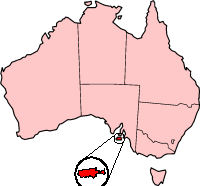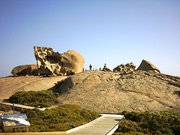Kangaroo Island
|
|
Kangaroo Island is Australia's third largest island - after Tasmania and Melville Island. It is situated 112 km southwest of Adelaide at the entrance of Gulf St. Vincent, 13 kilometres offshore from Cape Jervis, on the tip of the Fleurieu Peninsula in the state of South Australia.
| Contents |
Basic Facts and Figures
Geography
This island is 145km long and between 900 meters and 57 kilometers wide and covers an area of 4,405 square kilometres. Australia's third largest island has 509 kilometers of coastline and the highest elevations are on the north coast plateau reaching 307 meters above sealevel.
Climate
The winters between June and September are mild and wet, the summers usually warm and dry. Tempered by the ocean, particularly on the coastline, maximum temperatures in summer rarely exceed 35 degrees celsius. Average temperatures in August range between 13 to 16 degrees and in February, the hottest month, between 20 and 25 degrees. Between May and September the island receives 2/3 of its annual rainfall, varying from 450 mm in Kingscote to around 700mm near Cape du Couedic. Wettest month is July.
Population and Economy
About 4,100 inhabitants live on the island. 1,400 of them in Kingscote in 1991. The economy is mostly agricultural (vine, honey, wool, meat and grain). Beside this tourism and fishing play a role. Kangaroo island is famous for its honey and for being the oldest bee sanctuary in the world (since 1881).
Wildlife and its Protection
More than half of the island has never been cleared of vegetation. About 1/3 is conserved in National and Conservation Parks, including five Wilderness Protection Areas. The main protected areas are:
- Flinders Chase National Park
- Seal Bay Conservation Park
- Cape Gantheaume Wilderness Protection Area
- Cape Bouguer Wilderness Protection Area
- Ravine des Casoars Wilderness Protection Area
Because of its isolation from mainland Australia, foxes and rabbits are absent on the island. The Kangaroo Island Kangaroo, Tammar Wallaby, Brushtail Possum, Short Beaked Echidna, New Zealand Fur Seal are native on the island, such as six bat and frog species. The Koala, Ringtail Possum and Platypus have been introduced and still survive there. Kangaroo Island had a native species of Emu, the Dwarf Emu, however it became extinct between 1802 and official European settlement in 1836, perhaps due to Bushfires or from hunting by sealers or whalers.
The introduced Koalas have bred well and are starting to "eat themselves out of house and home", which may require transfer to suitable empty mainland sites, or culling.
Kangaroo Island is the last South Australian refuge of the endangered Glossy Black Cockatoo
Tourism
General Tourist Information (http://www.tourkangarooisland.com.au) is located in Penneshaw, Howard Drive and open 7 days a week.
Places of Interest
Admiral's_Arch.jpg
- Seal Bay with ranger guided walks among basking Australian sea lions
- Flinders Chase National Park which includes the Remarkable Rocks, Admiral's Arch, lighthouses at Cape Borda and Cape du Couedic and multiple walking trails and camping areas
- Cape Willoughby
- Kelly Hill Caves with guided cave tours
- Little Sahara, huge sand dunes on the south coast
- the island-lookout Mount Thisby (officially designated Prospect Hill in 2002 in honour of Matthew Flinders) with a 360 degree view around the island
- Murray Lagoon with its abundant aquatic bird life.
Restrictions
Little_Sahara.jpg
For quarantine reasons it is prohibited to bring honey products and bee-handling equipment to the island. Potatoes brought to the island must be in new packaging and vine cuttings and soil in which grapevines have grown are not to be brought without prior inspection. Rabbits are not permitted on the island. Shoes must be dusted when entering some national and conservation parks to prevent the spread of a fungi. The use of campfires are not permitted within national parks.
Lifestyle
Murray_Lagoon.jpg
Safe swimming is possible on the northern beaches, such as Emu Bay, Stokes Bay or Snelling Beach. The south coast has dangerous undertows and is not safe for swimming because of shark attacks on the sea lion colonies that are situated there.
Camping is permitted in approved local government camping areas, designated areas within National Parks and Caravan Parks. In other areas it is prohibited.
Accommodation can be found all across the island and should be booked in advance.
Shops and petrol stations can be found in the major villages Kingscote, Parndana, American River, Penneshaw (once called Hog Bay) and Vivonne Bay. Basic trading hours are Monday to Friday 9am to 5.30pm and Saturday 9am to 12noon.
The major Australian banks have branches in Kingscote. Automatic teller machines (ATM) are situated in Kingscote, Penneshaw and Parndana. Major Credit Cards are accepted in most places.
Connections to K.I.
Seal_Bay_Seals.jpg
Access to the island is via 30 minutes flight from Adelaide, the capital of South Australia or by sea ferry, one from Cape Jervis to Penneshaw, which takes about 50 minutes and another (suspended as of February 2005) from Wirrina to Kingscote which takes about 110 minutes.
Island's History
Cape_Borda_Lighthouse.jpg
Kangaroo Island was separated from mainland Australia by a rise in sealevel about 10,000 years ago. Stone tools found, suggest that Aboriginal people occupied the land at least 11,000 years ago; it is supposed that they disappeared in 200 b.c.. Theories about the cause include disease, warfare, climatic change or exodus.
In 1802 British explorer Matthew Flinders named the land "Kanguroo" Island, after landing near Kangaroo Head on the north coast of Dudley Peninsula. The biggest town on Kangaroo Island is Kingscote, originally established at Reeves Point on 27 July 1836, it is South Australia's first official European settlement.
Temperature and Weather
Cape_Willoughby_Lighthouse.jpg
- Average Annual Temperature: 11.6 - 19.1°C (52.9 - 66.4°F)
- Average January Temperature: 14.9 - 23.6°C (58.8 - 74.5°F)
- Average July Temperature: 8.4 - 14.6°C (47.1 - 58.3°F)
- Days over 30°C (86°F): 10.3
- Days over 35°C (95°F): 1.6
- Days under 2°C (35.6°F): 0.3
- Days under 0°C (32°F): 0.0
- Annual Rainfall: 485.1mm (19.1 inches)
- Average Annual Windspeed: 14.7 - 17.7 km/h (9.1 - 11.0 mp/h)
Kingscote climate averages (http://www.bom.gov.au/climate/averages/tables/cw_022807.shtml)
See Also
Links
- Toruism South Australia (http://www.southaustralia.com)
- Tour Kangaroo Island (http://www.tourkangarooisland.com.au/)
- Sealink (http://www.sealink.com.au) Cape Jervis to Penneshaw ferry-service.
- Kangaroo Island Ferries (http://www.kiferries.com/) Wirinna to Kingscote ferry-service.
- South Australia Central (http://www.sa.gov.au)
- Tourism Australia (http://www.australia.com/)
- Terraserver.com navigable satellite map of Kangaroo Island (http://terraserver.com/imagery/image_gx.asp?cpx=137.7&cpy=-35.8&res=250&provider_id=340&t=pan)da:Kangaroo Island
de:Känguru-Insel nl:Kangaroo Island pl:Wyspa Kangura sv:Kangaroo Island



